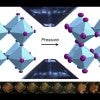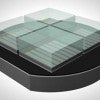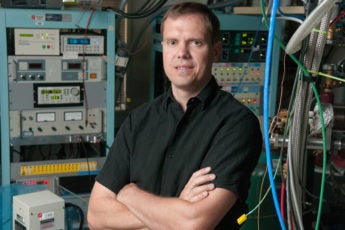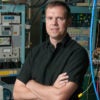Energy from renewable sources like the sun, wind, microbes or geothermal resources is already part of the energy mix in some markets, but current technologies only capture a limited amount of what those sources potentially offer. Continuing to expand renewable energy sources will require developments that lower prices and improve performance.
“I think a lot of progress is being made in renewable energy; the prices are coming down and it’s very exciting,” said Steven Chu, a professor of physics and of molecular and cellular physiology and former U.S. secretary of energy. “Part of the transition to carbon-free energy will rest on science and technology and innovation, and part of that are new materials.”
Cheap, efficient solar energy
Materials scientist Michael McGehee and other faculty members including chemist Hemamala Karunadasa have been experimenting with inexpensive materials like crystalline perovskites as possible replacements for the more expensive materials in existing solar panels. With these, the team hopes to rival the efficiency of traditional solar cells at a fraction of the price.
Go to the web site to view the video.
Likewise, engineer Jennifer Dionne is developing a technique that transforms lower-energy light to higher-energy waves to enhance the performance of solar cells. A different technology involves harvesting heat as well as light from the sun to boost energy capture.
While each approach targets different aspects of solar-energy capture, the idea is that some combination of these and other improvements could ultimately make high-efficiency solar energy more affordable, and several faculty members have founded companies to move that research forward.
Improved wind energy
In the area of wind energy, engineer John Dabiri has designed a compact wind farm, inspired by the movement of birds and fish, using wind turbines that spin on their vertical axis like eggbeaters. Positioned correctly, the devices capture more energy from the wind by taking advantage of vortices created by others in the group. Dabiri developed his novel turbine concept while on the faculty at the California Institute of Technology. In 2015 he came north to become part of the burgeoning energy community at Stanford.

Graduate student Shaun Milke installs electronics for a wind turbine designed by engineer John Dabiri in Igiugig, Alaska. (Image credit: Courtesy of John Dabiri and Jifeng Peng)

A vertical axis wind turbine developed by engineer John Dabiri at a test site in Igiugig, Alaska. (Image credit: Courtesy of John Dabiri and Jifeng Peng)
Dabiri is now testing his technology at a site in California and in a small town called Igiugig, Alaska, where people rely on expensive diesel for energy. Dabiri and his group have been experimenting with different designs for how to construct the turbine’s foundation and the tower, and exploring the best number of blades for the spinning rotor. The group is currently developing a microgrid that can combine the electricity produced by the wind turbines with energy from the diesel generators.
“Our goal is to be able to shut off the diesel generators entirely for parts of the winter when the cost of diesel fuel is highest but heat and light are essential,” Dabiri said.












